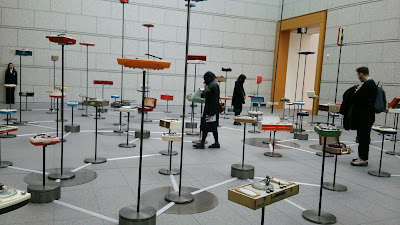A)
Spare-some-for-me Canal
About 300 years ago, there was a canal in the desolate
village (now Kameido 1-chome, Koto-ku).
The canal was surrounded by the dormant vegetation of shrubberies and
reed, but a good place for fishing.
The villagers often went to the canal to fish the
crucians or grays for their evening meals.
When the villagers start pack-up with a big bag of fishes and big smile
on their faces, a domineering voice came from the bottom of the canal; “Spare
some fishes for me.”
Some greedy fishers who have ignored the plea ended up
losing all the fishes or encountering a three-eyed hobgoblin or a huge tonsured
monster on their way home and never got home.
The villagers named the canal “spare-some-for-me canal”.
– A legend handed down from the old times.
A little piece of wood standing on the busy road side
now tells us that there was a canal once there.
End (translated by K.K.)
B)
A Crane’s Gratitude
Once upon a time, there was a young man living deep in
the snowy mountains. He was poor and
made his living by cutting firewood and selling it in a nearby village.
One winter’s day, the young man heard an odd sound on
his way home through the forest carrying his firewood. He crept through the bushes toward the sound
until he saw a crane with its leg was caught in a hunter’s trap. “Don’t be scared,” said the young man softly
and reached down and freed the crane from the trap. The crane flew off into the air.
That night, as the snow was falling thick and fast,
the young man heard a knocking at his door.
On the doorstep stood a beautiful woman, dressed in white, with
snowflakes in her long, black hair.
“I’m lost.
Could I stay here for a night?” The woman said.
“You can sleep in there,” the young man said gruffly,
pointing to the other room.
The following morning, the woman said “I’ve made you
something in thanks.” and showed him the most beautiful length of cloth he had
ever seen in his life. “You made that?”
he asked in disbelief. “I have my
ways. They are secret though. Anyway, you should try selling it.” She
said.
The young man scrambled out of bed and bursting into
the house of one of the merchants, “How much is this worth?” he said,
“Never seen anything like this before.” “I’ll give you this much for it.” said the
merchant. The young man went weak at the
knees.
After a month later, the young man said to the woman, “You
know, we seem to have used up all the money.
Weave us another, would you, my dear?”
“If you want, but promise me one thing, you will never
watch me weave. You have to promise me
that.” She said. “Yes, yes I promise,”
said the young man.
The following morning, the woman gave him the
cloth. A few days later, he approached
her again. “I think we should sell as
much of this stuff as we can now. Weave
us another one, would you?”
Over the next month, the woman wove many length of
this magnificent cloth. After a month
spent weaving, she looked haggard, pale and sad, like a ghost,
“I don’t think I can weave anymore,” she said. Then the young man thought to himself, “Perhaps
if I had a little look at what she’s doing in there, I could get some other
people to weave the cloth. Yes, I’ll
have a look.”
The young man crept to the door, opened it slightly,
and there he saw a crane sitting at the loom, plucking feathers from its body
and weaving them into the beautiful cloth.
The crane had few feathers left and there was blood on its bare
skin.
“You promised…..” she said sadly. “I am the crane that you saved. I came here to thank you for what you
did. But now you have seen me in my real
form, I must leave you.” She disappeared
into the snow, never to be seen again.
End (texts extracted from the “Japanese Folk Tales” by
The Japan Time)
(*)Shintoism is native religion of Japan, which is
characterized by the worship of numerous gods, ancestors and natural
phenomena. According to Shinto
principles, the gods exist in all natural objects. These gods are worshipped at
Shinto shrines. by K.K.
If you are interested in Shintoism, please join our free walking tour !










